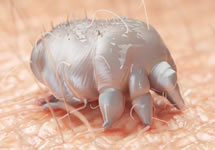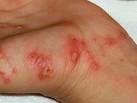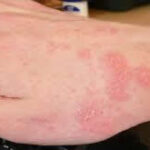Overview
 Human scabies is caused by an infestation of the skin by the human itch mite. The microscopic scabies mite burrows into the upper layer of the skin where it lives and lays its eggs. The most common symptoms of scabies are intense itching and a pimple-like skin rash. The scabies mite usually is spread by direct, prolonged, skin-to-skin contact with a person who has scabies.
Human scabies is caused by an infestation of the skin by the human itch mite. The microscopic scabies mite burrows into the upper layer of the skin where it lives and lays its eggs. The most common symptoms of scabies are intense itching and a pimple-like skin rash. The scabies mite usually is spread by direct, prolonged, skin-to-skin contact with a person who has scabies.
Causes
Scabies occurs worldwide and affects people of all races and social classes. Scabies can spread rapidly under crowded conditions where close body contact is frequent. Institutions such as nursing homes, extended-care facilities, and prisons are often sites of scabies outbreaks.
It is spread by direct contact with infected people and less often by sharing clothing or bedding.  Sometimes whole families are affected. The mites that cause scabies burrow into the skin and deposit their eggs, forming a burrow that looks like a pencil mark. Eggs mature in 21 days. The itchy rash is an allergic response to the mite.
Sometimes whole families are affected. The mites that cause scabies burrow into the skin and deposit their eggs, forming a burrow that looks like a pencil mark. Eggs mature in 21 days. The itchy rash is an allergic response to the mite.
Symptoms
- Itching, especially at night
- Rashes
- Sores (abrasions) on the skin from scratching and digging
- Thin, pencil-mark lines on the skin
Mites may be more widespread on a baby’s skin, causing pimples over the trunk, or small blisters over the palms and soles. In young children, the head, neck, shoulders, palms, and soles are involved. In older children and adults, the hands, wrists, genitals, and abdomen are involved.
Treatment
Prescription medicated creams are commonly used to treat scabies infections. The most commonly used cream is permethrin 5%. Other creams include benzyl benzoate and sulfur in petrolatum.
 Creams are applied all over the body. The whole family or sexual partners of infected people may need to be treated, even if they do not have symptoms.
Creams are applied all over the body. The whole family or sexual partners of infected people may need to be treated, even if they do not have symptoms.
For difficult cases, some health care providers may also prescribe medication taken by mouth to kill the scabies mites. Ivermectin is a pill that may be used.
Itching may continue after treatment begins, but will disappear if you follow your health care provider’s prescribed treatment plan. You can reduce itching with cool soaks and calamine lotion. Your doctor may also recommend an oral antihistamine.
How can I prevent getting scabies?
Prevent scabies by avoiding skin-to-skin contact with a person who has scabies and contact with items such as clothing or bedding used by a person infested with scabies mites.
What are the symptoms of scabies?
Common symptoms of itching and a pimple-like skin rash may affect much of the body or be limited to common places such as:
much of the body or be limited to common places such as:
- Between the fingers
- Wrist
- Elbow
- Armpit
- Genitals
- Nipple
- Waist
- Buttocks
- Shoulder blades
Symptoms affect the head, face, neck, palms and soles in infants and very young children, but usually not adults and older children.
When a person is first infested with scabies mites, it usually takes 2-6 weeks for symptoms to appear after being infested. If a person has had scabies before, symptoms appear 1-4 days after exposure.
An infested person can transmit scabies, even if they do not have symptoms, until they are successfully treated and the mites and eggs are destroyed.
How can scabies be treated?
Scabies should be treated with topical creams that can kill the mites, which are available by prescription from your health care provider. In addition to the infested person, treatment also is recommended for people they have been in contact with.
Bedding and clothing worn or used next to the skin anytime during the 3 days before treatment should be machine washed and dried using the hot water and hot dryer cycles or be dry-cleaned. Items that cannot be dry-cleaned or laundered can be disinfected by storing in a closed plastic bag for several days to a week. Scabies mites generally do not survive more than 2 to 3 days away from human skin. Children and adults usually can return to childcare, school, or work the day after treatment.
Persons with crusted scabies and their close contacts, including household members, should be treated rapidly and aggressively to avoid outbreaks. Institutional outbreaks can be difficult to control and require a rapid, aggressive, and sustained response.
Rooms used by a patient with crusted scabies should be thoroughly cleaned and vacuumed after use. Environmental disinfection using pesticide sprays or fogs generally is unnecessary and is discouraged as per CDC.